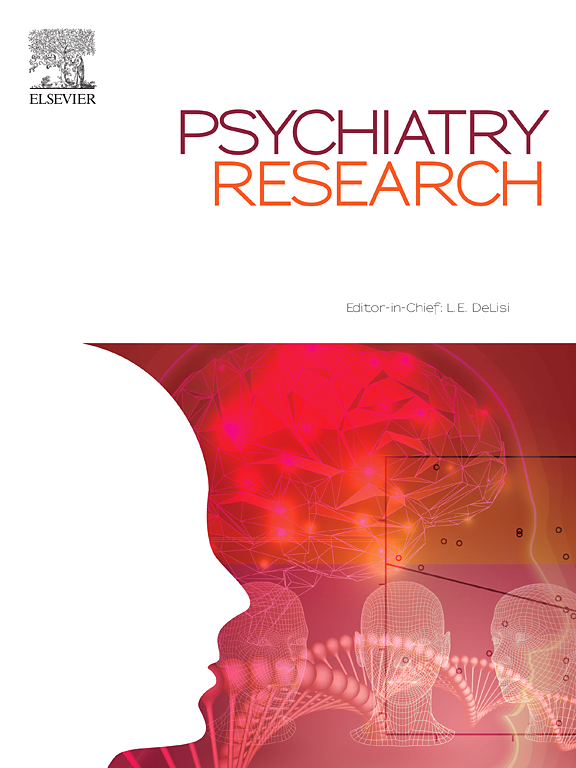Pain threshold and pain tolerance in young people with self-injurious behavior: A systematic review and meta-analysis
IF 3.9
2区 医学
Q1 PSYCHIATRY
引用次数: 0
Abstract
Background and Aims
Pain sensitivity has been proposed as a contributing factor to self-injurious behavior (SIB). Meta-analytic results show that individuals with SIB have lower pain sensitivity than healthy controls (HC). However, these findings are primarily based on adult populations. SIB typically begins in the early teen years and is most prevalent among youth. The aim of the present meta-analysis was to quantify the association of SIB and pain thresholds and pain tolerance in young people aged 10 to 24 years.
Methods
We performed a systematic search of the literature (MEDLINE, Web of Science Core Collection and PsycINFO) up until 10 December 2024. Titles, abstracts, and full texts were independently screened by multiple reviewers. Random-effects meta-analysis was performed on two pain-related outcomes: pain threshold and pain tolerance. The Preferred Reporting Items for Systematic Reviews and Meta-analyses guideline was followed. Quality assessment was performed using the Newcastle-Ottawa scale.
Results
Of 5200 screened studies, 221 full-text articles were retrieved whereof 8 studies fulfilled the criteria (n=592). Participants ranged from 10 to 22 years. Meta-analysis demonstrated statistically significantly higher pain threshold (Hedges’ g = 0.79, 95 % CI [0.13, 1.46]) in individuals with SIB compared to HC and no statistically significant difference in pain tolerance (Hedges’ g = 0.39, 95 % CI [-0.02; 0.79], p = 0.056).
Conclusions
Young people with SIB demonstrate higher pain thresholds compared to healthy controls, suggesting that lower sensitivity to painful stimulation may be a risk factor for SIB across developmental stages. Future studies should examine whether this association is independent of psychiatric comorbidity and other confounding factors.
自我伤害行为的年轻人疼痛阈值和疼痛耐受性:一项系统综述和荟萃分析
背景和AimsPain敏感性被认为是自伤行为(SIB)的一个促进因素。荟萃分析结果显示,SIB患者的疼痛敏感性低于健康对照(HC)。然而,这些发现主要是基于成年人群。SIB通常开始于青少年早期,在青少年中最为普遍。本荟萃分析的目的是量化10至24岁年轻人的SIB与疼痛阈值和疼痛耐受性的关系。方法系统检索截至2024年12月10日的文献(MEDLINE、Web of Science Core Collection和PsycINFO)。标题、摘要和全文由多位审稿人独立筛选。随机效应荟萃分析两种疼痛相关结果:疼痛阈值和疼痛耐受性。遵循系统评价和荟萃分析的首选报告项目指南。使用纽卡斯尔-渥太华量表进行质量评估。结果在5200项筛选研究中,检索到221篇全文文章,其中8项研究符合标准(n=592)。参与者年龄从10岁到22岁不等。荟萃分析显示,与HC相比,SIB患者的疼痛阈值(Hedges ' g = 0.79, 95% CI[0.13, 1.46])具有统计学意义,而疼痛耐受性(Hedges ' g = 0.39, 95% CI [-0.02];0.79], p = 0.056)。结论与健康对照相比,青少年SIB患者表现出更高的疼痛阈值,提示对疼痛刺激的敏感性较低可能是SIB在整个发育阶段的危险因素。未来的研究应该检查这种关联是否独立于精神疾病和其他混杂因素。
本文章由计算机程序翻译,如有差异,请以英文原文为准。
求助全文
约1分钟内获得全文
求助全文
来源期刊

Psychiatry Research
医学-精神病学
CiteScore
17.40
自引率
1.80%
发文量
527
审稿时长
57 days
期刊介绍:
Psychiatry Research offers swift publication of comprehensive research reports and reviews within the field of psychiatry.
The scope of the journal encompasses:
Biochemical, physiological, neuroanatomic, genetic, neurocognitive, and psychosocial determinants of psychiatric disorders.
Diagnostic assessments of psychiatric disorders.
Evaluations that pursue hypotheses about the cause or causes of psychiatric diseases.
Evaluations of pharmacologic and non-pharmacologic psychiatric treatments.
Basic neuroscience studies related to animal or neurochemical models for psychiatric disorders.
Methodological advances, such as instrumentation, clinical scales, and assays directly applicable to psychiatric research.
 求助内容:
求助内容: 应助结果提醒方式:
应助结果提醒方式:


